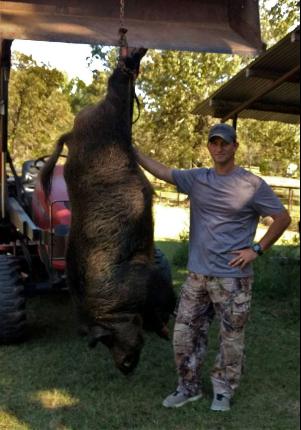Don’t Drink And Reload
BY Herschel SmithWell, I guess don’t drink and do anything with firearms would be even better counsel.
Well, I guess don’t drink and do anything with firearms would be even better counsel.
This is an interesting video. It wasn’t made to test the gun so much, but rather the BCG. He makes that very clear.
It sort of makes you wonder about those Soldiers complaining about firing 400 rounds through their Colt guns at Wanat and Kamdesh only to see their guns seize up.
First of all, remember that the Army hasn’t trained their men in fire control and marksmanship like the Marines. I’m not saying that – an experienced trainer who has time in Afghanistan is saying that.
Second, I maintain that the problems at Wanat had to do with being deployed at the bottom of a valley in between mountains, giving up the high ground, no logistics, no support, a poorly connected and poorly manned observation post, and a total time of more than a year from start to finish to build and man the COP (giving the Haqqani network time to deploy fighters at will). Again, see multiple entries on The Battle of Wanat. If you haven’t studied it, it’s a sad but necessary tale.
There is a rich history of blaming the gun for the failures when the real blame had to do with leadership, so it’s entirely misplaced blame to point to the gun. But it does cause you to wonder if those Colt guns had a better BCG would they have seized up after 400 rounds (400 rounds in 30 or so minutes at Wanat).
There are a lot of very good coated BCGs like this Titanium Nitride component. This is the guts of the gun. It makes sense to outfit yours with a good one.

How many of you think you could handle .450 Bushmaster in an AR pistol and regain sight picture after the first shot in – oh, I don’t know – under four or five seconds?
In 1949, the Soviet armed forces put a new, deadly assault rifle into general use, the AK-47. The Mikhail Kalashnikov design was soon disseminated around the world as a cheap, effective, durable military and police weapon.
America’s answer came fewer than 10 years later in a modification of the AR-10, a selective fire rifle first developed by Gosport, Indiana, native Eugene Stoner and two of his assistants at ArmaLite. A re-designed AR-10 was soon marketed to the military by Colt as the M-16, and was sold to the public as the AR-15.
Stoner died in 1997, during the 10-year period starting in 1994 when new AR-15s with certain features were outlawed for civilian use under the Federal Assault Weapons Ban. So, he wasn’t around to see the ban’s lifting in 2004. Since then, AR-15-style rifles have been a common denominator in several high-profile mass shootings.
Thursday was the fifth anniversary of the shooting at Sandy Hook Elementary School in Newtown, Connecticut. Twenty-eight people, including 20 5- and 6-year-old first-grade students, were shot to death.
There is no reasonable civilian purpose for this type of weapon. Unlike handguns, they offer no reliable accuracy at close range for home protection purposes. And, unlike bolt-action rifles and shotguns, they require little to no skill in the hunting realm.
This is a gun designed to kill as many people as possible as quickly as possible. Period.
The sad truth is that re-banning the AR-15 and the like won’t even begin to address the most prevalent weapon used in mass shootings: legally obtained handguns. That’s a much thornier issue. But, if we can’t even call the AR-15-style rifle a step too far, how do we imagine we’ll ever be able to address the larger gun problem in this country?
You learn something every day from the more educated gun owners, yes? AR-15s are great at (presumably) moderate to long ranges for “killing as many people as possible as quickly as possible.” But they “offer no reliable accuracy at close range for home protection purposes.”
Better work fast, men. Your trusted battle carbine is no good for CQB. By the way, Stephen Bayezes says hello. As do hundreds of thousands of Soldiers and Marines who have relied on said weaponry for room clearing operations.
Actually, it includes not just 5.56mm but popular .223 ammunition as well. The source is here. Read it all to find out his test method.
Here are the results.

In my opinion this isn’t a complete test. I would have liked to see PMC ammo tested as well, but he couldn’t include everything. I’m not interested in steel case ammunition. Also, I’d like to see some heavier loads tested (62 gr., 77 gr., etc.). This should be an ongoing series of articles and I found it useful.
Unless you do this sort of thing every day – and I don’t – it pays to rehearse some of the basics. These links are worth the study time today.
WRSA: Fighting in the Forrest
WRSA: Practical Marksmanship Lesson
WRSA: Practical Carbine Accuracy
M4Carbine.net: 5.56mm Trajectory
Sniper Central: .223 Remington
Sportsman’s Guide: Ballistics Charts
During the Vietnam war era, as a newly graduated mechanical engineer, I was hired by Colt’s Firearms, the original manufacturer of the M-16, and tasked with M-16 related assignments during my employment.
There was no commercially available civilian version of the AR-15 prior to the U.S. Military’s decision to make it the default military rifle replacing the M-14, and designating it as the M16A1. I have significant personal experience with the issues experienced by the M16A1, which were the result of a combined civilian/military screw-up. [JF note: this screwup was the subject of my original article.]
The AR-15 was developed specifically as a military weapon to replace the M-14. It was probably one of the first major weapons systems to be privately developed following the DOD’s decision to privatize the design and development function. This function had heretofore been carried out by publicly funded government operations, most notably, in the case of military small arms, the Springield Arsenal.
The AR-15 derived from a design by Eugene Stoner. His original design using that architecture and operating system was the AR-10, which used the 7.62mm NATO round. Seen today, it looks like an overgrown AR-15. The Armalite Company tasked two engineers with developing a version of the AR-10 that used the 5.56mm cartridge; these engineers were Jim Sullivan and Bob Fremont.
Only after civilian manufacturers like Colt’s made boatloads of money producing M16A1’s and selling them to the government did someone (I believe it was Colt’s Firearms) decide to make and sell a semi-automatic-only version of the weapon for civilian sale. It was, of course, known as the AR-15.
Small but significant changes were made to the architecture of the lower receiver, primarily slight relocation of pivot pins and redesign of the trigger/hammer components that pivoted on them, so that it would not be possible to acquire, legally or illegally, M16 trigger/hammer and fire selector components and thus easily convert the AR-15 to possess the same full automatic capability as the M16.
Like Eugene Stoner, whose mission was producing better equipment for the military, I do not believe that there is any place in the civilian world for a family of weapons that were born as an assault rifle. I am a staunch supporter of properly equipping our nation’s military but also of effective gun control for weapons available to civilians, to include banning those which are inappropriate outside a military context.
The author of this horrible commentary, James Fallows, cites a letter from a reader with no name whatsoever and with no indication that he has done his job of vetting this information.
One thing that makes me hold it suspect is that he gives a bit too much credit to Jim Sullivan and Robert Fremont, who weren’t the “engineers” in charge of the development of the AR-15. They were the designers, while Eugene Stoner was still the chief engineer behind the project.
But at any rate, even if this report is really from someone who worked as an engineer with Colt, so what? His statement that “Like Eugene Stoner, whose mission was producing better equipment for the military, I do not believe that there is any place in the civilian world for a family of weapons that were born as an assault rifle” just like the title of this article which is one of the best examples of overreach I’ve ever seen, is a world too far, and even more than that, is an outright lie.
Eugene Stoner never said that. If you think he did, prove it. Or shut up. I’m waiting.
Remember I recommended hunting hogs to save the environment? In Texas, a man is not only helping the environment, he’s making things safer for himself. From the Longview News-Journal.
A Union Grove man says he bagged the “big daddy” feral hog that was wreaking havoc on his property — all 416 pounds of him.
The Gregg County Game Warden’s office posted photos on Facebook this week showing Joe Clowers’ kill.
“This pig had been terrorizing his property for years — five or six,” said Game Warden Todd Long. “So every time he went hunting, he took a little extra firepower in case it showed up. Well, this time, it showed up.”
Clowers used a .223-caliber AR rifle to kill the pig.
The hog had preyed on the fawns in the area, and Clowers said he always stayed armed when visiting his deer feeders in case the hog in question charged him.
“My property lays between some populated areas, and I try to maintain an environment like a sanctuary or nursery for the deer to raise fawns,” Clowers said.
“He was the big daddy. I called him the ‘bush beast.’ “

This is a big hog to take down with an AR-15. I had wondered first of all where he shot him (was it a head shot?), and second, what ammunition he used?
Did he use standard 55 or 62 grain FMJ rounds, did he use 55 grain soft point rounds, or did he use heavier rounds such as the Hornady 75 grain or Sierra Matchking 77 grain? I suspect there are a lot of folks who would like to know.
I ended up talking to the Upshur County game warden via telephone, and he thought that the hog was taken with a standard round, at which I commented that it must have been with a head shot although I couldn’t tell anything from the pictures. He agreed and said that he believed it was taken with a head shot.
Congratulations to Mr. Clowers. Nice shot. Nice hog.
Via reader Pat Hines.
Reader David Dietz sends this from Recoil.
Amid ongoing reports of deteriorating sales in the black rifle market, firearms manufacturer Daniel Defense laid off an undisclosed number of employees. According to conversations with those affected and social media posts, on Friday, Sept. 29 and Monday, Oct. 2., the firearms manufacturer eliminated approximately 100 full-time positions.
A former employee of Daniel Defense affected by the layoffs said, “This was very unexpected. All of us were handed a blanket packet that explained everything. The paperwork didn’t even have my name on it. All they said about my job was that my position was being eliminated. There was no severance package, we were just fired.”
The scope of the layoff is unknown, but firsthand sources including current and recently laid off employees speaking under the condition of anonymity said anywhere from a third to a half of the company’s workforce was affected.
Speaking about the terms of employment at Daniel Defense and the layoff, one laid off employee said, “We all had to sign a non-compete. I think the non-compete I signed was for 2 years. The outgoing talk and paperwork didn’t specify the non-compete being lifted. It’s unfortunate for a lot of people who don’t have skills outside of the industry.”
According to former employees, Daniel Defense’s post-termination non-compete clause is contained in a standard employment agreement employees sign as they are brought aboard. It is used to protect the employer’s interests by preventing employees from working for a competing company for a certain amount of time, stipulated in the non-compete clause.
When asked about the existence of a post-termination non-compete agreement, the terms, and whether it will be enforced, officials from Daniel Defense refused the opportunity to comment.
Well, Daniel Defense has a right to force employees to sign non-compete agreements as a condition of employment. But this is a shame for the former employees of Daniel Defense, who only know how to do one thing. Hopefully they can keep their machinist skills up-to-date enough to return to the workforce when the agreement has been fulfilled.
On the other hand, one has to question the wisdom of Daniel Defense. If they were prepared to throw good money after Super Bowl commercials (and apparently they were), and if their rifles are almost priced out of the market, and they are, then it seems wise to cut costs and MSRP, tighten the belt, and even cut employee salaries in an attempt to stay afloat.
This way (with the history of the non-compete agreement preventing employees from seeking other similar gainful employment), it would seem to me hard to hire good employees in the future.


